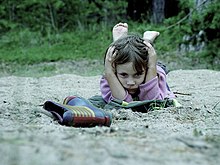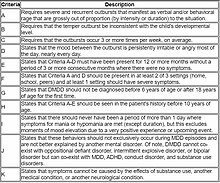Bipolar I disorder is a type of bipolar spectrum disorder characterized by the occurrence of at least one manic episode, with or without mixed or psychotic features. Most people also, at other times, have one or more depressive episodes.

The Diagnostic and Statistical Manual of Mental Disorders is a publication by the American Psychiatric Association (APA) for the classification of mental disorders using a common language and standard criteria. It is the main book for the diagnosis and treatment of mental disorders in the United States and Australia, while in other countries it may be used in conjunction with other documents. The DSM-5 is considered one of the principal guides of psychiatry, along with the International Classification of Diseases ICD, CCMD, and the Psychodynamic Diagnostic Manual. However, not all providers rely on the DSM-5 as a guide, since the ICD's mental disorder diagnoses are used around the world and scientific studies often measure changes in symptom scale scores rather than changes in DSM-5 criteria to determine the real-world effects of mental health interventions.

Attention deficit hyperactivity disorder (ADHD) is a neurodevelopmental disorder characterised by executive dysfunction occasioning symptoms of inattention, hyperactivity, impulsivity and emotional dysregulation that are excessive and pervasive, impairing in multiple contexts, and otherwise age-inappropriate.
Schizoaffective disorder is a mental disorder characterized by abnormal thought processes and an unstable mood. This diagnosis requires symptoms of both schizophrenia and a mood disorder: either bipolar disorder or depression. The main criterion is the presence of psychotic symptoms for at least two weeks without any mood symptoms. Schizoaffective disorder can often be misdiagnosed when the correct diagnosis may be psychotic depression, bipolar I disorder, schizophreniform disorder, or schizophrenia. This is a problem as treatment and prognosis differ greatly for most of these diagnoses.

A mood swing is an extreme or sudden change of mood. Such changes can play a positive part in promoting problem solving and in producing flexible forward planning, or be disruptive. When mood swings are severe, they may be categorized as part of a mental illness, such as bipolar disorder, where erratic and disruptive mood swings are a defining feature.
Adult Attention Deficit Hyperactivity Disorder is the persistence of attention deficit hyperactivity disorder (ADHD) in adults. It is a neurodevelopmental disorder, meaning symptoms must have been present in childhood except for when ADHD occurs after traumatic brain injury. Specifically, for ADHD, multiple symptoms must have been present before the age of 12, according to DSM-5 diagnostic criteria. This cutoff age of 12 is a change from the previous requirement of symptom onset before the age of 7 in the DSM-IV to add flexibility in the diagnosis of adults. ADHD was previously thought to be a childhood disorder that improved with age, but recent research has disproved this. Approximately two-thirds of childhood cases of ADHD continue into adulthood, with varying degrees of symptom severity that change over time, and continue to significantly affect individuals' daily functioning in multiple domains.

Intermittent explosive disorder is a behavioral disorder characterized by explosive outbursts of anger and/or violence, often to the point of rage, that are disproportionate to the situation at hand. Impulsive aggression is not premeditated, and is defined by a disproportionate reaction to any provocation, real or perceived. Some individuals have reported affective changes prior to an outburst, such as tension, mood changes, energy changes, etc.
Irritability is the excitatory ability that living organisms have to respond to changes in their environment. The term is used for both the physiological reaction to stimuli and for the pathological, abnormal or excessive sensitivity to stimuli.
Oppositional defiant disorder (ODD) is listed in the DSM-5 under Disruptive, impulse-control, and conduct disorders and defined as "a pattern of angry/irritable mood, argumentative/defiant behavior, or vindictiveness". This behavior is usually targeted toward peers, parents, teachers, and other authority figures, including law enforcement officials. Unlike conduct disorder (CD), those with ODD do not generally show patterns of aggression towards random people, violence against animals, destruction of property, theft, or deceit. One half of children with ODD also fulfill the diagnostic criteria for ADHD.
A major depressive episode (MDE) is a period characterized by symptoms of major depressive disorder. Those affected primarily exhibit a depressive mood for at least two weeks or more, and a loss of interest or pleasure in everyday activities. Other symptoms can include feelings of emptiness, hopelessness, anxiety, worthlessness, guilt, irritability, changes in appetite, difficulties in concentration, difficulties remembering details, making decisions, and thoughts of suicide. Insomnia or hypersomnia and aches, pains, or digestive problems that are resistant to treatment may also be present.

Bipolar disorder in children, or pediatric bipolar disorder (PBD), is a rare mental disorder in children and adolescents. The diagnosis of bipolar disorder in children has been heavily debated for many reasons including the potential harmful effects of adult bipolar medication use for children. PBD is similar to bipolar disorder (BD) in adults, and has been proposed as an explanation for periods of extreme shifts in mood called mood episodes. These shifts alternate between periods of depressed or irritable moods and periods of abnormally elevated moods called manic or hypomanic episodes. Mixed mood episodes can occur when a child or adolescent with PBD experiences depressive and manic symptoms simultaneously. Mood episodes of children and adolescents with PBD are different from general shifts in mood experienced by children and adolescents because mood episodes last for long periods of time and cause severe disruptions to an individual's life. There are three known forms of PBD: Bipolar I, Bipolar II, and Bipolar Not Otherwise Specified (NOS). The average age of onset of PBD remains unclear, but reported age of onset ranges from 5 years of age to 19 years of age. PBD is typically more severe and has a poorer prognosis than bipolar disorder with onset in late-adolescence or adulthood.

The Diagnostic and Statistical Manual of Mental Disorders, Fifth Edition (DSM-5), is the 2013 update to the Diagnostic and Statistical Manual of Mental Disorders, the taxonomic and diagnostic tool published by the American Psychiatric Association (APA). In 2022, a revised version (DSM-5-TR) was published. In the United States, the DSM serves as the principal authority for psychiatric diagnoses. Treatment recommendations, as well as payment by health care providers, are often determined by DSM classifications, so the appearance of a new version has practical importance. However, not all providers rely on the DSM-5 for planning treatment as the ICD's mental disorder diagnoses are used around the world and scientific studies often measure changes in symptom scale scores rather than changes in DSM-5 criteria to determine the real-world effects of mental health interventions. The DSM-5 is the only DSM to use an Arabic numeral instead of a Roman numeral in its title, as well as the only living document version of a DSM.
Bipolar II disorder (BP-II) is a mood disorder on the bipolar spectrum, characterized by at least one episode of hypomania and at least one episode of major depression. Diagnosis for BP-II requires that the individual must never have experienced a full manic episode. Otherwise, one manic episode meets the criteria for bipolar I disorder (BP-I).
Joseph Biederman was Chief of the Clinical and Research Programs in Pediatric Psychopharmacology and Adult ADHD at the Massachusetts General Hospital and a professor of psychiatry at Harvard Medical School. Biederman was board-certified in general and child psychiatry.
Cyclothymia, also known as cyclothymic disorder, psychothemia / psychothymia, bipolar III, affective personality disorder and cyclothymic personality disorder, is a mental and behavioural disorder that involves numerous periods of symptoms of depression and periods of symptoms of elevated mood. These symptoms, however, are not sufficient to indicate a major depressive episode or a manic episode. Symptoms must last for more than one year in children and two years in adults.
Childhood schizophrenia is similar in characteristics of schizophrenia that develops at a later age, but has an onset before the age of 13 years, and is more difficult to diagnose. Schizophrenia is characterized by positive symptoms that can include hallucinations, delusions, and disorganized speech; negative symptoms, such as blunted affect and avolition and apathy, and a number of cognitive impairments. Differential diagnosis is problematic since several other neurodevelopmental disorders, including autism spectrum disorder, language disorder, and attention deficit hyperactivity disorder, also have signs and symptoms similar to childhood-onset schizophrenia.
The associated features of bipolar disorder are clinical phenomena that often accompany bipolar disorder (BD) but are not part of the diagnostic criteria for the disorder. There are several childhood precursors in children who later receive a diagnosis of bipolar disorder. They may show subtle early traits such as mood abnormalities, full major depressive episodes, and attention-deficit hyperactivity disorder. BD is also accompanied by changes in cognition processes and abilities. This includes reduced attentional and executive capabilities and impaired memory. How the individual processes the world also depends on the phase of the disorder, with differential characteristics between the manic, hypomanic and depressive states. Some studies have found a significant association between bipolar disorder and creativity.
The Child Mania Rating Scales (CMRS) is a 21-item diagnostic screening measure designed to identify symptoms of mania in children and adolescents aged 9–17 using diagnostic criteria from the DSM-IV, developed by Pavuluri and colleagues. There is also a 10-item short form. The measure assesses the child's mood and behavior symptoms, asking parents or teachers to rate how often the symptoms have caused a problem for the youth in the past month. Clinical studies have found the CMRS to be reliable and valid when completed by parents in the assessment of children's bipolar symptoms. The CMRS also can differentiate cases of pediatric bipolar disorder from those with ADHD or no disorder, as well as delineating bipolar subtypes. A meta-analysis comparing the different rating scales available found that the CMRS was one of the best performing scales in terms of telling cases with bipolar disorder apart from other clinical diagnoses. The CMRS has also been found to provide a reliable and valid assessment of symptoms longitudinally over the course of treatment. The combination of showing good reliability and validity across multiple samples and clinical settings, along with being free and brief to score, make the CMRS a promising tool, especially since most other checklists available for youths do not assess manic symptoms.
Externalizing disorders are mental disorders characterized by externalizing behaviors, maladaptive behaviors directed toward an individual's environment, which cause impairment or interference in life functioning. In contrast to individuals with internalizing disorders who internalize their maladaptive emotions and cognitions, such feelings and thoughts are externalized in behavior in individuals with externalizing disorders. Externalizing disorders are often specifically referred to as disruptive behavior disorders or conduct problems which occur in childhood. Externalizing disorders, however, are also manifested in adulthood. For example, alcohol- and substance-related disorders and antisocial personality disorder are adult externalizing disorders. Externalizing psychopathology is associated with antisocial behavior, which is different from and often confused for asociality.
Borderline personality disorder (BPD) is a psychological disorder characterized by chronic instability of relationships, self-image, moods, and affect, which is frequently misdiagnosed. This misdiagnosis can come in the form of providing a BPD diagnosis to a person who does not actually meet criteria or providing an incorrect alternative diagnosis in the place of a BPD diagnosis.








